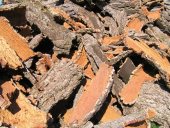Hi folks!
We are Martyn (Ashkenah) and Emilie, inspired by your good selves, Geoff Lawton and others, we are under a year into our permaculture homestead project called Ahimsa Food Forest (also on facebook). At Ahimsa Food Forest we are developing a new sustainable roofing technique. We have made a campaign on WeTheTrees.com to raise support for our unique cork reciprocal roof and would
really appreciate it if you would share the link with your network of friends and acquaintances.
http://www.wethetrees.com/campaigns/unique-reciprocal-cork-roof
The full campaign text is here:
1. Who We Are
We are Ashkenah and Emilie, we are forest gardeners. We dream of a sustainable, harmonious and loving world. Ahimsa Food Forest is the concept of a way of life based on cooperation not competition, where our individuality and creativity is celebrated and our togetherness embraced. Food forests are my personal passion! Ever since I first visited a food forest 10 years ago I have believed that this is the key to the ecological, economic, social and psychological problems in the world. It is my life's work to plant as much food forest as possible.
2. First Things First
Our primary need is to complete a sustainable natural house for ourselves, our children and our volunteers to live in.
Without suitable functional housing we cannot focus our attention on the full implementation of the food forest. Attached is the design of the house, made to be thermally efficient and from completely sustainable materials.
In the last nine months we have built a compost toilet, dug several swales and hugel beds, planted polyculture veg and seed gardens. We have planted 50 metres of edible hedge. We have also built the timber frame for the house with reciprocal roof frame. The next step is to lay the roof tiles, so that the cob walls can be protected from the rain as they are built. This is where we are asking for your help.
We have an innovative idea for roofing material: raw virgin cork. This material is lightweight, waterproof, sound resistant, fire resistant, rot resistant and highly insulating. And it is incredibly beautiful. Locally produced, in the unprocessed state in which we will use it, the carbon footprint is almost non-existent. In comparison to other roofing possibilities (tiles, slates, metal roof panels, wooden shingles, or synthetic materials) virgin cork has a very low embodied energy, with high durability and excellent thermal qualities.
The challenge is fitting it all together! Each piece is unique and irregular, so it's like a jigsaw but you have to shape each piece to fit. This is perhaps why there are no reported cases of this material being used in this way before. However, we think it's potential is so great that we have invested much time and patience into finding the techniques to work efficiently with cork, including the best tools for cutting, shaping and fixing it all together on batons, how to prevent it drying out and splitting from prolonged solar exposure, etc. We now have some knowledge, to progress we need a large quantity of material. So, after successful small scale trials we have decided to make a leap and pioneer this technique on our house!
3. The campaign
This campaign has the objective of raising 1500 euros to buy 1.5 metric tonnes of virgin cork. This will provide roofing for the main house, the compost toilet, the chicken house and the dog kennel.
Your generous contributions will be essential to the establishment of Ahimsa Food Forest and to pioneering this roofing technique. Therefore also raising awareness of sustainable living in this area and afar, enriching the lives of people and ecosystems.
Thank you!
About Ahimsa Food Forest
We are nine months into our start up permaculture project at Ahimsa Food Forest in central Portugal. This region, Viseu, has mainly monoculture forestry and petrol-chemical based agriculture. All this industrial activity is subsidised with taxpayers money to keep it going, at continuous cost to the environment. Indeed most of the mixed broad leaf forest has now been replaced with pine and eucalyptus plantations, soil is therefore eroding, the rivers run dryer every year and the young people relocate to large cities in the hope of finding a future. An established productive food forest can open peoples hearts and minds to the possibility and productivity of cooperating with nature. With a food forest we can connect to our locality through food and skills sharing.
In case you don't know: Ahimsa is sanskrit for (more or less) "non-violence". It was a word often used by Gandhi and others to promote peaceful protest. In a world where the ecological destruction is devastating and the stability of the current social-economic system is questionable, Ahimsa provides a complete practical ethic for living in union with all living things. Peaceful protest means non-cooperation or non-participation in harmful activities, and non-participation in military-industrial-agricultural social practices can lead us to utopia!
We welcome visitors at pre-arranged times to Ahimsa Food Forest between the months of May and October. If you want to know more, please have a look at our facebook page Ahimsa Food Forest.
You can read more about cork here:
https://www.corkor.com/blogs/wikicork/72695557-where-does-cork-come-from




